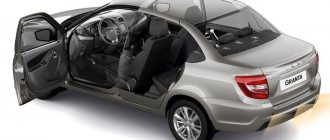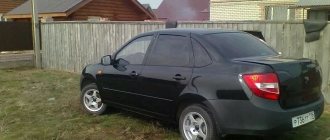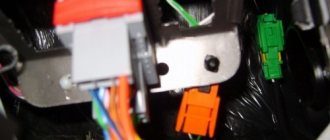How much gasoline can be poured into the Lada Granta gas tank: volume in liters
A gas tank (fuel tank) is a container in a car where fuel is stored. Typically the gas tank is installed at the rear bottom of the body. This arrangement has a good effect on the “weight distribution” of the car. On the Lada Granta the gas tank is made of plastic.
Fuel tank volume Lada Granta
How much can this beauty put into our Granta?
The volume of the fuel tank, regardless of the configuration, on a Lada Granta car is 50 liters.
Add to this no more than 2 liters, which will be in the fuel line and fuel filter, and you will get the maximum volume that can be filled into this car. You only need to refuel with 95-grade gasoline, which is what the manufacturer recommends.
Remember that you only need to “fill up to full” before the trip. Otherwise, during long-term parking under the influence of external factors, gasoline vapors will evaporate through special holes in the gas tank. This will be especially noticeable in hot weather.
When “filling the tank to full”, the first shooting of the column will occur at 45 liters. In this case, the fuel level on the instrument panel will be indicated “without one division to full.” It is because of this that disputes arise that the gas tank is actually smaller than the volume stated by AvtoVAZ in the technical documentation. In my experience, after the first shooting in the “slow pour” mode, it is possible to fill about 6 more liters.
By simple mathematical addition operations, the volume of all gasoline in the system is at least 51 liters, which corresponds to the information declared by the car manufacturer.
P.S. I only fill up with 92nd gasoline.
External view of the fuel tank
Fuel tank from a used Lada Granta car.
The design of the Lada Granta does not provide a drain hole on the gas tank, so gasoline can only be drained by acting on the fuel rail or through the fuel filter.
When does the low fuel warning light come on?
Indicator lamp for low gasoline level when the volume of fuel in the gas tank is no more than 7 liters.
Filling volumes of the Lada Granta car
To provide more detailed information, we have created a table with all the refueling volumes of the Lada Granta car. It is presented below.
NameValue
| Engine cooling and interior heating system* | 7,84 |
| Transmission | 3,1 |
| Hydraulic brake system | 0,45 |
| Windshield washer reservoir | 5,0 |
| Fuel tank (capacity) | 50 |
How to make it to the gas station if there is catastrophically little fuel?
Closing the windows will improve the car's aerodynamics. If the air conditioner is working, you will have to say goodbye to it for now, since it consumes gasoline excessively. You don’t have to turn off the music and headlights, especially the latter – road safety depends on them. The movement should be uniform: do not accelerate too much and do not brake sharply.
Today, many cars are equipped with cruise control - this miracle of engineering helps to maintain a certain speed. Automatic cars are more economical than manual ones because they change gears themselves and according to a clear algorithm. Excess cargo does not help save fuel: if you are traveling with a trailer, leave it if possible - then return when you replenish your fuel supply. Don’t abuse your car’s “patience”: it’s better to refuel to the maximum right away, delighting your inner driver with a full tank. Do not delay a trip to the gas station if the level is approaching the light bulb: sooner or later this will still have to be done - and it is better to repair the gas pump sooner than later.
Tank volume of Lada Granta: technical characteristics
Lada Granta is a fairly popular car among Russian consumers.
Its price is reasonable, and operation is much cheaper than a foreign car. However, not all owners can accurately indicate the main parameters of this machine. In this article we will tell you what the volume of the fuel tank in the Lada Granta is.
A little about Grant
As you know, the manufacturer created the Lada Granta based on an earlier model, the Kalina. The car is now supplied to the market in four modifications:
There are also three types of configuration. Both the luxury version and the “Standard” and “Norma” are equipped with 1.6-liter engines of varying power. At first, the car was supplied with power plants with 8 valves, but then 16 valves appeared.
All modifications use a 5-position gearbox. It can be automatic or manual. The front wheels are driven.
The manufacturer recommends using only AI-95 for refueling, but many claim that the car feels great when running on 92.
According to the standard, fuel consumption per hundred kilometers is:
- in urban conditions – 8.7-9.3;
- on highways – 5.8-6.2;
- mixed cycle - 7.2-7.3 liters.
Granta is able to reach a maximum speed of more than 168 kilometers per hour. It needs a maximum of 12 seconds to accelerate to hundreds.
The gasoline tank is installed behind the Grant, under the body, on the right side. This arrangement allows the car to be perfectly balanced, which, in turn, makes it easier to drive. The fuel tank is made of plastic.
Among other things, the designers also made certain changes to the suspension design during the development of the car in question. In particular, a wider caster was installed in the front, this had a positive effect on the vehicle's directional stability.
At the same time, the steering rack was also updated; it is now somewhat shorter than the one installed on Kalina, thanks to this, only three turns of the steering wheel are required for a full turn. This made driving the car much easier
The front suspension also has a new strut module, whose design has undergone a number of changes and has received completely new characteristics as a result.
The stabilizers that provide lateral stability are stronger, as are the body supports.
During the modernization, attention was also paid to the rear suspension. So Granta became the first car in the history of the Volzhsky Automobile Plant to have negative wheel camber values. And this measure greatly improves the vehicle's handling.
What is the volume of the gas tank
Regardless of the modification of the Grant, the volume of its fuel tank is the same and is exactly 50 liters.
To this amount of gasoline should be added about 2 liters already supplied to the fuel supply system and the fuel filter. As a result, the maximum fuel for Grant will be 52 liters.
As previously noted, the car manufacturer indicates that only 95 gasoline should be used. In turn, reviews indicate that the car drives much more economically with this brand than with the cheap 92. Although critics note that they have no problems with the latter type of fuel - studies have proven that in total, their expenses (albeit insignificantly) , but higher.
G-Energy S SYNTH • Owner reviews
| Lada Granta FL fuel consumption measurements, what is everyone silent about? So, if the car is mainly operated in a temperate climate with mild, warm winters and not very hot summers, as well as with low engine loads, then the optimal use of semi-synthetic oils with viscosity classes according to SAE 10W-30 or 10W-40 temperature range from -20 to 35 degrees. Lubricant refilling location Filling volume Liquid oil name Fuel tank 50 l Unleaded gasoline with an octane rating of at least 95 Engine lubrication system 3.5 l Motor oils according to the Ford Motorcraft Formula E 5W-30 classification or according to the SAE classification, API quality level not lower than SG 5W -30, 5W-40, 10W-40 Engine cooling and interior heating systems 7.84 l Motorcraft Super Plus Antifreeze 2000 WSS-M97B44-D Gearbox 3.1 l Gear oil WSD-M2C 200-C Hydraulic brake system 0.45 l Fluid for automatic transmissions WSS-M2C 924-A Windshield washer reservoir 5 l Hydraulic fluid Ford Power Steering Fluid WSA-M2C 195-A. |
- Anton, Sevastopol. I owned a used foreign car, and in 2013 I bought a Lada Granta. The new car lived up to expectations - a nice sedan that feels great in the city, with good capabilities on dirt roads thanks to the adapted suspension. The 82 horsepower engine pulls well, has already covered 100 thousand km - no problems, just changed the oil and oil filter. In the city with the air conditioning on, consumption from 10 liters in the suburban cycle can be kept within 6.
- Valery, Ryazan. I have a Lada Granta with an engine capacity of 1.6 and a power of 82 horses, I bought it in 2014. Before that I had many VAZ models, I consider this one the most balanced, reliable and comfortable. If you wish, you can find shortcomings, but the price fully corresponds to the quality offered. Very reliable ride, so far I've only changed the brake pads. In the combined cycle, the real fuel consumption is about 7.5 liters per hundred, I refuel with AI 95.
- Bogdan, Stavropol region. I bought my Lada Granta in 2015, so far I’m not complaining. The rigid suspension is very durable and this suits me; the 82 horsepower engine with a distributed fuel injection system copes with its duties perfectly. The only thing that worries me is that the engine takes oil, and its gasoline consumption is no more than 10 liters, even in winter.
- Denis, Bryansk. I have a Lada Granta, a model with an engine power of 82 horsepower with a manual transmission. An excellent option for the city, one of the most reliable VAZ cars. I would like to note the reliability and acceptable fuel consumption of around 7 liters, a little more in winter than in summer. The disadvantages include no sound insulation, which is tiring on long trips.
- Anatoly, Perm. I needed an economical, inexpensive car for the city, so I chose the Lada Granta with an 82 horsepower engine. The interior is comfortable, but hard plastic creates acoustic discomfort. There are no complaints about the suspension, engine and transmission. The car consumes 6 liters on the highway and up to 9 in the city.
- Sergey, Kharkov. I have a 2012 Lada Granta with a 1.6 engine with 82 horsepower and a manual transmission. Over the entire period, no problems arose; the interior is very comfortable for a Lada, and the trunk is spacious. The chassis is a bit harsh, but very reliable; I only changed the oil and filter for the engine. The average consumption is about 7 liters of AI 95.
Lada Granta fuel tank capacity
As a fuel tank in any car, including the Lada Granta, there is a special container that allows you to ensure the safety of fuel. In most modern cars, the filling tank is located in the rear part under the bottom. This option was not chosen by manufacturers by chance, since it allows them to achieve the required weight distribution. In the Lada Granta model, the tank is made of plastic.
How to activate the immobilizer on Grant
How to install a roof rack on a Lada Granta
Granta what is included in the standard Lada Granta
What is the tank volume in Grant?
The fuel tank capacity for the model reviewed here, regardless of equipment level, is 50 liters. To the indicated value you can add a couple of liters contained in the fuel line and the power system filter, and you will get the maximum volume of fuel. The manufacturer recommends using “95” gasoline.
It should be remembered that it is recommended to fill the tank completely before the actual trip. If after refueling the vehicle is expected to remain idle for a long time, then fuel will evaporate under the influence of external factors through the ventilation system in the refueling tank. This point is especially relevant in hot weather.
When fuel is supplied from the pump to the tank, and the owner of the Lada Granta intends to fill it to capacity, the first “shooting” of the fuel nozzle occurs at the 45th liter. The corresponding instrument panel indicator will display the fuel level symbol without the last illuminated division. This fact gives rise to a lot of heated debate, the essence of which is the opinion that the actual volume of the gas tank present in the Lada Grant is compared with the value declared by the manufacturer. Taking into account the experience of the owners, it can be argued that in the “slow refueling” mode it is possible to add about six more liters.
Using the basics of mathematics, we get the value: the total volume of the gas tank is 51 liters, and this corresponds to the manufacturer’s statements.
Design feature of the tank?
In the LADA Granta tank, the designers did not provide a hole for draining fuel. If such a need arises, then this procedure is carried out through the system filter or fuel rail. In this case, the volume of the fuel tank does not change.
When does the warning symbol light up indicating low fuel level?
The level lamp is activated when the remaining volume present in the fuel tank reaches 7 liters.
Refueling volumes
For the purpose of a more informative perception of the given data, we have created a table reflecting the values of refueling volumes for the LADA Granta model. It is located in the text below.
Criteria for choosing gasoline
What is the tank volume of the Hyundai solaris?
When choosing the appropriate fuel option, the car owner must take a number of rules as a basis:
In the event that it will be used both in warm and cold seasons, it is recommended to pay attention to the volatility class of the purchased gasoline. Requirements for this substance vary depending on the area of operation, but for the most part suppliers strive to offer a universal product, which should be chosen for the Lada Granta car. Gasoline should not contain dangerous impurities such as lead, iron or manganese
Such a product is rightfully considered to be of poor quality and can damage the car’s fuel system. Most manufacturers, in an effort to protect the tank from corrosion and destruction, add so-called additives to gasoline. However, you should not add such a substance yourself to the finished product. It would be more advisable to purchase a premium product, which will provide maximum protection.
In real life, the choice varies between two brands of gasoline poured into the tank: 92 and 95. Domestic drivers use both options with equal success, but determining the best one is quite difficult.
The manufacturer of the Lada Granta recommends using 95 gasoline due to its high quality. This gasoline is supplied purified, without foreign impurities. In addition, it has cleansing properties, to which there is a rather ambivalent attitude. On the one hand, such fuel does not allow dust and dirt to penetrate into the gas tank container, on the other hand, with constant use it has a destructive effect on the metal itself.
92nd gasoline is rightfully considered much more benign, as it contains nothing other than the raw material required by the manufacturing technology. In addition, refilling this product will be an order of magnitude cheaper than its 95 equivalent.
When choosing the right gasoline, the car owner must pay attention to the recommendations given by the manufacturer and adapt them to his region and the needs of the car.
How many liters is the tank on a Grant sedan?
Today I was setting up and calibrating my BC. Therefore, it became necessary to fill the gas tank to capacity (to the neck). At the same time I found out how much fuel actually fits there. When I looked for this information, no one could say for sure. I had to check the volume of the gas tank in my own way. To begin with, I pumped out the gasoline until the “reserve” light came on. This corresponds to 5 liters of gasoline in the tank. I went to the gas station to fill the tank full. (All this was needed to calibrate the FLS in the BC). I arrived at Gazprom. I asked the gas station attendant to fill it up to the neck with a slow top-up, to which he nodded))). I went to the cashier and said it was full. After refueling, I finished off the gas and went to the car. Just in case, I asked the guy again if he topped it up to the neck. To which he nodded again...))) Well, okay. I get into the car and accelerate away from there. I look at the tidy - the last division is naturally empty. I look at the receipt - 40.9 liters. In short, roughly 46 liters came in with the reserve. Well, I think it was natural for him to add a little bit at a time. The gun simply clicked off and the tanker dealt with my request...
Everyone probably already understands the structure of the Grant filler neck? You've probably noticed more than once that when you fill up a full tank, the last bar on the dashboard is sometimes empty. The thing is that when about 45-47 liters are filled, gasoline begins to splash out of the neck under strong pressure. Naturally the gun knocks back. And this is where the refueling ends. And then disputes arise about the actual volume of the tank. Like they said 50 liters. but in fact it fits 45. So this is all not true... Read more...
After an obvious underfill of gasoline, I went to another gas station. I’m coming to LukOil. A young guy comes out. I explain the situation to him, saying that I need to fill the tank full, filling it a little at a time up to the neck. He himself went to the operator and said to pour until full. Slowly, at my request, I filled the petrol up to the filler neck... How much more do you think will fit? And 7.6 liters fit.
In short, according to calculations, it is clear that a full tank before failure is 53-54 liters. Something like that ))))
The 1st generation Lada Granta Sedan in the 2190 body was shown to the general public in 2011 and soon mass production began at the concern's parent automobile plant in the city of Tolyatti. For a long time, this machine has been one of the best-selling models on our market.
The Granta family also includes: Liftback, Hatchback, Universal and Sport.
How to determine the amount of gasoline in the tank accurate to the nearest liter
Gasoline consumption multiplied by its cost can be the decisive argument in choosing a car, but it is often not enough to know how much fuel is burned according to regulations and in reality. When the indicator gives a signal that there is little fuel, and especially if it fails and the light does not light up at all, the most important question arises: how to find out how much gasoline is left?
Folk tricks
A stationary device that could measure the amount of fuel in the tank with an accuracy of up to a liter is not included in any of the most complete configurations of modern cars. But among car enthusiasts and specialists, on automotive forums, you can find a lot of advice on determining these residues: from rocking the car to evaluate the sound (the less gasoline, the louder the splashes) to weighing it and comparing it with the weight in the owner’s manual. One of these original algorithms for measuring fuel residues is to drain it from the tank into a measuring container, and then pour it back into the tank.
Of course, there are more reasonable methods that are suitable in road conditions.
By instruments
If the fuel indicator is working, the first solution is to navigate it. For example: the volume of the tank is 50 liters, 10 divisions are conventionally marked on the scale, which means that each “beats” 5 liters. When estimating the remaining fuel in this way, remember that the result will be approximate, and pay attention to the location of the car: the car must be strictly horizontal, otherwise the indicator will not correspond to reality.
More accurate readings can be obtained using a special probe. The gas tanks of some old cars were supplied with it from the factory, but by analogy you can do it yourself, having studied the topic well. The distance between the cutoffs depends on the size and shape of the tank; the length of the ruler must be at least one and a half meters, and the material from which it is made must not contain metal and not create sparks.
Using diagnostic mode
If your car has a dashboard from the Renault family, which selectively includes LADA, Nissan and some others, you can find out how much gasoline is in the tank, accurate to the nearest liter, in the panel diagnostic mode.
To run diagnostics on the device, you need to:
– before turning on the ignition, hold down the daily mileage reset button for 5 seconds, then turn on the ignition and release the button when the instrument needles begin to move;
– use the same button to switch the diagnostic mode of the instrument panel, finding the gas pump icon in the upper right corner.
Below this icon a number is displayed that exactly corresponds to the volume of fuel remaining in the gas tank.
You can check whether the diagnostic mode of the instrument panel will work on a specific car experimentally.
With sensor
If the dashboard does not support the test mode capabilities described above, the problem of monitoring the amount of gasoline in the car’s tank can be solved using a special wireless sensor installed directly in the gas tank.
A modern device runs on a battery with increased autonomy (up to five to seven years!) and is capable of storing data on changes in fuel level for an average of two months in the built-in memory. The fuel level can be read remotely at any time using a special device that recognizes a radio signal.
Using calculations
For those who love calculations, there is another method that requires preliminary preparation. By filling a full tank and resetting the odometer, you can easily calculate the actual volume of the gas tank and fuel consumption per 100 km in the usual driving mode, which will further help control the fuel level.
Video of starting diagnostic mode
Modifications of Lada Granta Sedan
1.6 l hp 132 Nm and 5-speed manual transmission VAZ 21901.6 l 11186 87 hp 140 Nm and 5-speed manual transmission VAZ 21811.6 l 21126 98 hp 144 Nm and 4-automatic transmission JF414E| 1.6 l hp 132 Nm and 5-speed manual transmission VAZ 2181 |
| 1.6 l 21127 106 hp 148 Nm and 5-speed manual transmission VAZ 21806 |
| 1.6 l 21127 106 hp 148 Nm and 5-speed gearbox AMT 2182 |
Our portal has separate and detailed material about all Grant engines.
What was the update of the 2022 model, says the AutoReview website
ARTICLE
What you need to pay attention to when buying a used Granta read here
Technical characteristics of Lada Granta Sedan
Using the example of a sedan with a 1.6 liter 87 hp power unit. and manual transmission:
Dimensions and weight
Length 4268 mm Width 1700 mm Height 1500 mm Wheelbase 2476 mm Front track 1430 mm Rear track 1414 mm Turning circle 10.2 m Ground clearance 160 mm Curb weight 1160 kg Gross weight 1560 kg Trunk volume 520 l Load capacity 400 kgDynamics and fuel consumption
Engine power 87 hp Torque 140 Nm Acceleration up to 100 km/h 11.6 s Max. speed 172 km/h Consumption in the city 9.1 l Consumption on the highway 5.3 l Mixed consumption 6.8 l Tank volume 50 lSpecifications
Front drive Power steering electric Front suspension MacPherson strut Rear suspension Torsion beam Tire size 175/65 R14 El. assistants ABS, EBD, BAS Front brakes disc Rear brakes drumHow to fill your own gasoline?
How many liters is the volume of the Toyota Corolla tank, the volume of the Toyota Corolla gas tank
Having decided which gasoline to fill, the motorist can go to a gas station to get fuel, where a professional gas station attendant will come to the rescue. However, in some cases he will have to fill the gasoline himself.
Refueling may be required along the way, so you should always have a canister and funnel with you
You should refuel when there is less than half the tank left. Many inexperienced drivers prefer to drive until the light on the dashboard lights up, indicating that the tank is almost empty. This practice is quite risky and can significantly harm the motor system. Gasoline cools the fuel pump, which, if overheated, will simply burst. If the tank is filled according to the rules, you can safely go to the gas station.
When approaching a gas station, it is important to park the car correctly in front of the gas station with the side on which the gas tank cap is located. It is advisable to park the car so that the gas tank and gas station are on the same level
After this, you should unscrew the gas tank cap and insert a refueling nozzle of the appropriate brand into it.
After this, you need to make a payment and indicate how many liters of fuel are required. Returning to the car, you need to press the lever on the gun, then the fuel will be supplied automatically.
At the same time, the motorist must know how to drain gasoline from the tank if he comes across a low-quality product. This can be done in three main ways.
Especially for your convenience, all technical characteristics of the Lada Granta are collected on one page. There are five different combinations of engines and gearboxes, which is why they are presented in this table. The Lada Granta was originally conceived as a replacement for the “Classic”, which is why engineers did not pursue the dynamism and elegance of the new product. On the contrary, Granta was created to be the most economical, versatile and convenient car at a very modest price.
Technical characteristics of the new Grant:
| Lada Granta Sedan | 1.6 l 8-cl., manual transmission, 87 hp. | 1.6 l 8-cl., manual transmission | 1.6 l 16-cl., manual transmission, 106 hp. | 1.6 l 16-cl., manual transmission | 1.6 l 16-cl., automatic transmission |
| dimensions | |||||
| Length, width, height, mm | 4260 / 1700 / 1500 | ||||
| Wheelbase, mm | 2476 | ||||
| Ground clearance, mm | n/a | ||||
| Front track, mm | 1430 | ||||
| Rear track, mm | 1414 | ||||
| Weight in running order/total, kg | 1115 / 1560 | ||||
| Trunk volume, l | 520 | ||||
| Engine | |||||
| engine's type | four-stroke, gasoline | ||||
| Maximum power, kW/rev. min. | 64 / 5100 | 60 / 5100 | 78 / 5800 | 72 / 5600 | 72 / 5600 |
| Maximum torque, Nm / rev. min. | 140 / 3800 | 132 / 3800 | 145 / 4000 | 145 / 4000 | 145 / 4000 |
| Engine volume, cm3 | 1596 | 1596 | 1596 | 1596 | 1596 |
| Transmission | |||||
| type of drive | Front | ||||
| Gearbox / number of gears | mechanical / 5 | mechanical / 5 | mechanical / 5 | mechanical / 5 | automatic/ 4 |
| Dynamic characteristics | |||||
| Maximum speed, km/h | 167 | 165 | 177 | 172 | 168 |
| Acceleration 0-100 km/h, s | 12,4 | 12,6 | 11,0 | 11,4 | 13,7 |
| Fuel consumption | |||||
| Urban cycle, l/100km | n/a | n/a | n/a | n/a | n/a |
| Extra-urban cycle, l/100km | n/a | n/a | n/a | n/a | n/a |
| Mixed cycle, l/100km | 7,0 | 7,4 | 6,7 | 6,8 | 7,6 |
| Fuel type | unleaded gasoline AI-95 (min) | ||||
| Fuel tank volume, l | 50 | ||||
| Rest | |||||
| Permissible total weight of the towed trailer with/without brakes, kg | 900 / 450 | ||||
| Tires | 175/70 R13 (82, T, H) | 175/65 R14 (82, H); 185/60 R14 (82, N); 185/55 R15 (H, V) | 175/65 R14 (82, H); 185/60 R14 (82, N); 185/55 R15 (H, V) | 175/65 R14 (82, H); 185/60 R14 (82, N); 185/55 R15 (H, V) |
Price of Lada Granta 2190 on the secondary market
Official dealers estimate such a sedan new in the range from 440 to 630 thousand rubles.
On the secondary market, prices start from 100,000 and reach 500,000 rubles for a car with low mileage.
You can contact the site administrator by email: [email protected]
All texts were written by me, are authored by Google, included in the original Yandex texts and notarized. For any borrowing, we immediately write an official letter on company letterhead in support of search networks, your hosting and domain registrar.
Next we go to court. Don’t try your luck, we have more than thirty successful Internet projects and have already won a dozen lawsuits.
As a fuel tank in any car, including the Lada Granta, there is a special container that allows you to ensure the safety of fuel. In most modern cars, the filling tank is located in the rear part under the bottom. This option was not chosen by manufacturers by chance, since it allows them to achieve the required weight distribution. In the Lada Granta model, the tank is made of plastic.
Price information
So far, only cars in two trim levels are on sale: standard and norm, and only in a sedan body. The hatchbacks will go on sale in early 2013. The starting price for a car in the basic configuration is 229 thousand rubles. The standard equipment will cost 256 thousand, and you will have to pay an additional 8,000 rubles for the wheels. The cost of the “luxury” version is not yet known exactly, but according to AvtoVAZ representatives, it will not exceed 270-280 thousand rubles. From mid-2012, Lada Granta cars with a Japanese automatic transmission can go on sale. It is not known how much such a Grant will cost, but AvtoVAZ representatives say that the cost of a car with automatic transmission will be about 300 thousand rubles.
What is the tank volume in Grant?
The fuel tank capacity for the model reviewed here, regardless of equipment level, is 50 liters. To the indicated value you can add a couple of liters contained in the fuel line and the power system filter, and you will get the maximum volume of fuel. The manufacturer recommends using “95” gasoline.
It should be remembered that it is recommended to fill the tank completely before the actual trip. If after refueling the vehicle is expected to remain idle for a long time, then fuel will evaporate under the influence of external factors through the ventilation system in the refueling tank. This point is especially relevant in hot weather.
When fuel is supplied from the pump to the tank, and the owner of the Lada Granta intends to fill it to capacity, the first “shooting” of the fuel nozzle occurs at the 45th liter. The corresponding instrument panel indicator will display the fuel level symbol without the last illuminated division. This fact gives rise to a lot of heated debate, the essence of which is the opinion that the actual volume of the gas tank present in the Lada Grant is compared with the value declared by the manufacturer. Taking into account the experience of the owners, it can be argued that in the “slow refueling” mode it is possible to add about six more liters.
Using the basics of mathematics, we get the value: the total volume of the gas tank is 51 liters, and this corresponds to the manufacturer’s statements.
Main performance characteristics Grants
The new product has a length of 4246 mm (for the sedan 4260), a width of 1700 mm and a height of 1500 mm. The wheelbase of the liftback is similar to the sedan - 2476 mm, the same situation with the front track - 1430 mm and the rear - 1414. In running order, the Lada Granta in the liftback body has a mass of 1160 kg, and the total weight is 1560 kg. It is the slightly larger mass that makes a car with a five-door body less dynamic, but the difference is a fraction of a second and not a single driver will be able to distinguish the difference. Among the other technical characteristics of the LADA Granta Liftback, it is worth noting the trunk of 440 liters, which can be increased by folding the rear seats up to 760 liters. Let us remember that the liftback is slightly shorter than the sedan, which is why the trunk volume is slightly smaller when the rear seats are folded down. The fuel tank capacity of the new product is 50 liters, the permissible towed load weight is 450 kg, and if the trailer has brakes, its total weight can be up to 900 kg. The Granta liftback is equipped with three different engines -
- 8-valve petrol engine with 87 hp.
- 16-valve petrol engine producing 98 hp.
- 16-valve petrol engine with 106 hp.
Refueling volumes
For the purpose of a more informative perception of the given data, we have created a table reflecting the values of refueling volumes for the LADA Granta model. It is located in the text below.
Fuel tank volume of Lada Granta: capacity and filling volumes
A gas tank (fuel tank) is a container in a car where fuel is stored. Typically the gas tank is installed at the rear bottom of the body. This arrangement has a good effect on the “weight distribution” of the car. On the Lada Granta the gas tank is made of plastic.
Fuel tank volume Lada Granta
The volume of the fuel tank, regardless of the configuration, on a Lada Granta car is 50 liters.
Add to this no more than 2 liters, which will be in the fuel line and fuel filter, and you will get the maximum volume that can be filled into this car. You only need to refuel with 95-grade gasoline, which is what the manufacturer recommends.
Remember that you only need to “fill up to full” before the trip. Otherwise, during long-term parking under the influence of external factors, gasoline vapors will evaporate through special holes in the gas tank. This will be especially noticeable in hot weather.
When “filling the tank to full”, the first shooting of the column will occur at 45 liters. In this case, the fuel level on the instrument panel will be indicated “without one division to full.” It is because of this that disputes arise that the gas tank is actually smaller than the volume stated by AvtoVAZ in the technical documentation. In my experience, after the first shooting in the “slow pour” mode, it is possible to fill about 6 more liters.
By simple mathematical addition operations, the volume of all gasoline in the system is at least 51 liters, which corresponds to the information declared by the car manufacturer.
External view of the fuel tank
The design of the Lada Granta does not provide a drain hole on the gas tank, so gasoline can only be drained by acting on the fuel rail or through the fuel filter.
When does the low fuel warning light come on?
Indicator lamp for low gasoline level when the volume of fuel in the gas tank is no more than 7 liters.
Filling volumes of the Lada Granta car
To provide more detailed information, we have created a table with all the refueling volumes of the Lada Granta car. It is presented below.
If you find an error, please select a piece of text and press Ctrl+Enter.
Dimensions
Chassis
Fuel
Engine
The most common fuel tank sizes in cars are 40, 50, 60 and 70 liters. Judging by the volume of the tank, you can tell how big the car is. In the case of a 30 liter tank, we are most likely talking about a small car. 50-60 liters is a sign of a strong middle peasant. And 70 indicates a full-size car.
The volume of the fuel tank would be a useless quantity if it were not for fuel consumption. Knowing the average fuel consumption, you can easily calculate how many kilometers a full tank of fuel will last you. On-board computers of modern cars are able to quickly show this information to the driver.
The fuel tank volume of the Lada Granta is 50 liters.
Is it dangerous to drive cars with an “empty tank”?
Car owners often wonder whether it is safe to drive a car with a minimum fuel level or whether this can lead to serious engine damage. It is immediately necessary to make a reservation that the harm of such operation will largely depend on how often you have to operate the vehicle with a minimum level of fuel. If you constantly fill up with gasoline, but one day such an alarm appeared on the highway or in the city, after which you literally refueled after 5-10 kilometers, then, of course, there will be no harm to the car. But if this happens constantly, then the fuel pump, filter and engine may develop certain problems.
The fact is that the fuel pump, which supplies pressure to the system, is located in the gas tank, cooled and lubricated by the fuel in which it is immersed. If there is a minimum amount of fuel left in the tank, then the pump, although it pumps gasoline, can heat up when running dry, which ultimately leads to the failure of this expensive element. As a result, the car owner will expect expensive repairs, which in most cases will consist of replacing the pump pump.
Also, when operating a vehicle with a minimum fuel level, the pump can supply gasoline to the system from the very bottom of the tank, where water, heavy fractions and various dirt usually accumulate. As a result, all this gets into the system, clogs the injectors and can completely damage the car’s engine. It is not surprising that car owners who often forget to refuel on time have numerous problems with fuel systems and injectors, and such cars will subsequently require expensive repairs or engine replacement. It has also been established that such frequent trips in a car with a minimum of fuel left in the tank lead to failure of the catalyst, and this is one of the most expensive parts in a car. If you do not want to pay several thousand dollars in the future just to replace such an exhaust system, then it is still recommended to refuel the car in a timely manner, which will eliminate various types of breakdowns and problems with the operation of the equipment.
Let's sum it up
If a light comes on in your car indicating that the fuel level is insufficient, then you can be guaranteed to drive 40-50 kilometers, which should be enough to find a gas station and solve existing problems with gasoline or diesel fuel. In each specific case, the mileage of a car on a half-empty tank will differ, taking into account the volume of the tank, fuel consumption and a number of other factors. It is still not worth operating a car that has a minimum of gasoline left, as this will invariably lead to serious breakdowns, the elimination of which will require significant financial costs.
10.01.2019
How much gasoline can be poured into the Lada Granta gas tank - volume in liters
Lada Granta is a fairly popular car among Russian consumers. Its price is reasonable, and operation is much cheaper than a foreign car. However, not all owners can accurately indicate the main parameters of this machine.
Fuel tank volume of Lada Granta: capacity and filling volumes
A gas tank (fuel tank) is a container in a car where fuel is stored. Typically the gas tank is installed at the rear bottom of the body. This arrangement has a good effect on the “weight distribution” of the car. On the Lada Granta the gas tank is made of plastic.
About the light bulb and tolerances
Many manufacturers indicate the fuel level in the operating instructions for the car, others in the specifications on websites or dealer networks. To be honest, there is simply no single norm! It all depends on the shape of the tank and its design, but there is an unspoken standard:
To be honest, I measured it on my car once (I simply don’t advise you to do more, you’ll understand why later) - I have about 60 kilometers. It is also worth noting that, purely structurally, there are, as it were, two divisions on the AVEO.
The first is when “LOW” is written, one stick on the tank scale lights up, then it will last for about 70 km.
The second is when the “lamp” also lights up - then it remains for 50 kilometers.
By the way, on many cars, the inscription may light up, and not the gas station icon.
How much gasoline can be poured into the Lada Granta gas tank: volume in liters
A gas tank (fuel tank) is a container in a car where fuel is stored. Typically the gas tank is installed at the rear bottom of the body. This arrangement has a good effect on the “weight distribution” of the car. On the Lada Granta the gas tank is made of plastic.
Fuel tank volume Lada Granta
How much can this beauty put into our Granta?
The volume of the fuel tank, regardless of the configuration, on a Lada Granta car is 50 liters.
Add to this no more than 2 liters, which will be in the fuel line and fuel filter, and you will get the maximum volume that can be filled into this car. You only need to refuel with 95-grade gasoline, which is what the manufacturer recommends.
Remember that you only need to “fill up to full” before the trip. Otherwise, during long-term parking under the influence of external factors, gasoline vapors will evaporate through special holes in the gas tank. This will be especially noticeable in hot weather.
When “filling the tank to full”, the first shooting of the column will occur at 45 liters. In this case, the fuel level on the instrument panel will be indicated “without one division to full.” It is because of this that disputes arise that the gas tank is actually smaller than the volume stated by AvtoVAZ in the technical documentation. In my experience, after the first shooting in the “slow pour” mode, it is possible to fill about 6 more liters.
By simple mathematical addition operations, the volume of all gasoline in the system is at least 51 liters, which corresponds to the information declared by the car manufacturer.
P.S. I only fill up with 92nd gasoline.
External view of the fuel tank
Fuel tank from a used Lada Granta car.
The design of the Lada Granta does not provide a drain hole on the gas tank, so gasoline can only be drained by acting on the fuel rail or through the fuel filter.
When does the low fuel warning light come on?
Indicator lamp for low gasoline level when the volume of fuel in the gas tank is no more than 7 liters.
Filling volumes of the Lada Granta car
To provide more detailed information, we have created a table with all the refueling volumes of the Lada Granta car. It is presented below.
NameValue
| Engine lubrication system | 3,5 |
| Engine cooling and interior heating system* | 7,84 |
| Transmission | 3,1 |
| Hydraulic brake system | 0,45 |
| Windshield washer reservoir | 5,0 |
| Fuel tank (capacity) | 50 |
Main malfunctions in the sensor operation
If the sensor does not display the fuel level correctly, you can judge that a certain breakdown has occurred and needs to be repaired. Modern sensors that record the fuel level, like all vehicle parts, fail from time to time. In this case, it is necessary to repair the fuel level sensor.
Malfunction in indicators
The main sign of a sensor failure is the display of false data displayed on the pointer. Based on its “behavior,” certain conclusions can be drawn regarding the resulting breakdown. Here are the most basic types of breakdowns and their causes:
The indicator is at zero, regardless of the fuel level. The problem is that the float stop is broken. The pointer moves, but still drops to the zero mark. In this case, you need to pay attention to the general condition of the device winding, as well as the reliability of the contact between the sensor and the current collector. Fluctuations in fuel quantity indicators. This malfunction indicates sufficient wear on the contacts. When starting the engine, the fuel gauge does not rise above the zero mark. Such a malfunction is directly related to the electronics of the vehicle
Here it is important to check the wires for possible breaks and the degree of reliability of the connection. It is important to ensure the overall integrity of the fuse. Low fuel light does not light up
This problem is often associated with device failure. The fuel level sensor is lying. In such a situation, it will be necessary to check the float for the level of tightness.
According to modern traffic regulations, operating a car with a faulty indicator is strictly prohibited. Problems that arise with sensors must be eliminated as promptly as possible.
Mechanical and functional malfunction
Along with problems that are expressed in incorrect indicators, sensor failure can manifest itself in the following malfunctions:
- loss of tightness of the built-in float;
- strong bending of the wire holder;
- violation of the general tightness of the housing and the resulting decrease in the level of resistance;
- mechanical break of the variable resistor;
- loss of tightness at the point where the device is attached to the fuel tank.
After the float loses proper tightness, the control device, with a full tank, will indicate an incomplete fuel level. If there is a sufficiently strong loss of tightness, the indicator will immediately show the minimum fuel level. In this case, the actual quantity will not matter. To fix this problem, you will need to remove the sensor and replace the float. If it is not possible to purchase a float, you will need to completely replace the entire device.
Quite often, the sensor fails due to long-term movement over rough or uneven terrain. Repeated impacts on the tank will cause serious damage to the wire holder of the built-in float.
With such bends, the behavior of the indicator will directly depend on where the holder was bent. If the bend is directed upward, the parameters will always be increased, if downward, the parameters will be underestimated. If the breakdown involves such a bend, you just need to straighten the wire holder and give it its original shape.
Often the seal of the sensor housing is broken. This happens after an accident has occurred, as well as after long-term use of low quality fuel. If gasoline gets into the device, it will malfunction and, as a result, cause incorrect sensor readings. These malfunctions can only be eliminated by completely replacing the device.
If the variable resistor breaks, this will cause the sensor to always show a full or completely empty tank. Similar signs can be observed in the process of a break in the signal wire running from the sensor to the display unit. Before removing the sensor, you will need to connect a variable resistor with a resistance level of 100 - 200 Ohms to the car body and to the signal contact. As you rotate the knob, you need to make sure that the sensor readings change. In this case, the malfunction can only be eliminated by completely replacing the device.
The main sign of a complete loss of tightness at the installation site of the device is the appearance of the smell of gasoline in the cabin.
A little about Grant
As you know, the manufacturer created the Lada Granta based on an earlier model, the Kalina. The car is now supplied to the market in four modifications:
There are also three types of configuration. Both the luxury version and the “Standard” and “Norma” are equipped with 1.6-liter engines of varying power. At first, the car was supplied with power plants with 8 valves, but then 16 valves appeared.
All modifications use a 5-position gearbox. It can be automatic or manual. The front wheels are driven.
The manufacturer recommends using only AI-95 for refueling, but many claim that the car feels great when running on 92.
According to the standard, fuel consumption per hundred kilometers is:
- in urban conditions – 8.7-9.3;
- on highways – 5.8-6.2;
- mixed cycle - 7.2-7.3 liters.
Granta is able to reach a maximum speed of more than 168 kilometers per hour. It needs a maximum of 12 seconds to accelerate to hundreds.
The gasoline tank is installed behind the Grant, under the body, on the right side. This arrangement allows the car to be perfectly balanced, which, in turn, makes it easier to drive. The fuel tank is made of plastic.
Among other things, the designers also made certain changes to the suspension design during the development of the car in question. In particular, a wider caster was installed in the front, this had a positive effect on the vehicle's directional stability.
At the same time, the steering rack was also updated; it is now somewhat shorter than the one installed on Kalina, thanks to this, only three turns of the steering wheel are required for a full turn. This made driving the car much easier
The front suspension also has a new strut module, whose design has undergone a number of changes and has received completely new characteristics as a result.
The stabilizers that provide lateral stability are stronger, as are the body supports.
During the modernization, attention was also paid to the rear suspension. So Granta became the first car in the history of the Volzhsky Automobile Plant to have negative wheel camber values. And this measure greatly improves the vehicle's handling.
Installing a separate engine temperature indicator
The Grant was initially equipped with an 8-valve engine, which was of two types. The main difference between them was that one of them has a power of 80 horsepower, and the other - 90. This engine accelerates the car to hundreds in just 12.0 seconds. The maximum speed of the car is up to 168.5 km/h. These figures are quite decent despite the fact that this car is a budget car. All Grants are petrol and their consumption per 100 kilometers is from 8.3 to 9.3 liters in the city, and outside the city - from 5.8 to 6.1 liters.
Lada Granta fuel tank capacity
As a fuel tank in any car, including the Lada Granta, there is a special container that allows you to ensure the safety of fuel. In most modern cars, the filling tank is located in the rear part under the bottom. This option was not chosen by manufacturers by chance, since it allows them to achieve the required weight distribution. In the Lada Granta model, the tank is made of plastic.
How to activate the immobilizer on Grant
How to install a roof rack on a Lada Granta
Granta what is included in the standard Lada Granta
What is the tank volume in Grant?
The fuel tank capacity for the model reviewed here, regardless of equipment level, is 50 liters. To the indicated value you can add a couple of liters contained in the fuel line and the power system filter, and you will get the maximum volume of fuel. The manufacturer recommends using “95” gasoline.
It should be remembered that it is recommended to fill the tank completely before the actual trip. If after refueling the vehicle is expected to remain idle for a long time, then fuel will evaporate under the influence of external factors through the ventilation system in the refueling tank. This point is especially relevant in hot weather.
When fuel is supplied from the pump to the tank, and the owner of the Lada Granta intends to fill it to capacity, the first “shooting” of the fuel nozzle occurs at the 45th liter. The corresponding instrument panel indicator will display the fuel level symbol without the last illuminated division. This fact gives rise to a lot of heated debate, the essence of which is the opinion that the actual volume of the gas tank present in the Lada Grant is compared with the value declared by the manufacturer. Taking into account the experience of the owners, it can be argued that in the “slow refueling” mode it is possible to add about six more liters.
Using the basics of mathematics, we get the value: the total volume of the gas tank is 51 liters, and this corresponds to the manufacturer’s statements.
Design feature of the tank?
In the LADA Granta tank, the designers did not provide a hole for draining fuel. If such a need arises, then this procedure is carried out through the system filter or fuel rail. In this case, the volume of the fuel tank does not change.
When does the warning symbol light up indicating low fuel level?
The level lamp is activated when the remaining volume present in the fuel tank reaches 7 liters.
Refueling volumes
For the purpose of a more informative perception of the given data, we have created a table reflecting the values of refueling volumes for the LADA Granta model. It is located in the text below.
External view of the fuel tank
The design of the Lada Granta does not provide a drain hole on the gas tank, so gasoline can only be drained by acting on the fuel rail or through the fuel filter.
Should you refrain from filling your tank full?
There are many different rumors circulating on the Internet about this, presented as the opinions of “experts,” but not all of them turn out to be true.
In particular, a significant percentage of car owners are convinced that refueling a car to a full tank is dangerous only because in this case it is difficult to avoid fraud on the part of gas station employees. And they even provide specific diagrams - while you go to the cash register, the gas station attendant takes out a small canister from the wide pocket of his trousers and safely fills it. Well, or something like that.
In fact, if a gas station employee is engaged in such “strawling”, it does not matter how much gasoline you fill - 10 liters or 50 (although theoretically in the latter case he can steal more, but still in compliance with the proportion). Technically, it is difficult to implement this particular method of deception, given that it can be relatively easily detected. There are many more sophisticated fuel theft schemes, and it is not our task to describe them.
Another common argument why it is impossible or undesirable to refuel a full tank is the assertion that such refueling makes the car heavier, and due to an increase in weight by 30-40-50 kg, its dynamics deteriorate. Of course, it’s hard to take such statements seriously – just one extra adult passenger in the cabin weighs at least twice as much. Finally, we put a lot of necessary and unnecessary things in the trunk, without thinking at all that this is also additional ballast.
There is also a category of real paranoids who are convinced that if you leave a car with a full tank in the parking lot, then the next day you will definitely not have at least half a tank of fuel. In principle, there are methods for determining how full the gas tank is, but they require the use of expensive locating tools, so in a normal situation it would be ridiculous to worry about this. You can simply sympathize with such car owners, because they should worry not so much about gasoline, but about the vehicle itself - it can be stolen with no less probability!
Let us note that draining gasoline from a foreign car is not so easy, and the newer the car, the more difficult it is to do, starting with breaking the hatch and ending with the need to solve the problem of the complex structure of the neck with many protective devices.
But all of the above does not mean that a tank “to capacity” is good. There are also completely rational arguments explaining why it is dangerous to refuel your car to a full tank.
In particular, this is the likelihood of filling with low-quality fuel. If your warning light comes on, and the nearest gas station turns out to be out of network, you are unlikely to be able to determine how high-quality gasoline they will fill you with. So in such cases, you really should fill up the minimum amount of gas just to get to a well-known gas station.
Finally, a very convincing argument not in favor of refueling the car to the edges of the filler neck is the risk of disrupting the operation of the gas tank ventilation system, since it is designed to fill the standard amount of fuel. This risk lies in the fact that the ventilation valve is located in the neck shaft, but not at its surface, so it will not work until the gasoline level drops. This means that a vacuum will form in the container, which may affect the operation of the fuel pump. If you practice this kind of refueling regularly, you can safely say that the gas pump will exhaust its resource much earlier than expected.
However, the latest generation of cars are equipped with a compensatory ventilation system that takes into account the possibility of fuel overflowing beyond the norm - they are not threatened by such a problem.
Another likely consequence of refueling to capacity is the possibility of excess gasoline/diesel fuel leaking out or splashing either directly through the filler cap or through the drain pipes. The last option is the most undesirable, since the chemically active liquid can get on rubber parts located in the engine compartment, damaging them, on electrical wiring, on parts of the brake system, power unit or transmission. And if gasoline gets on the components of the exhaust system, which is heated to ultra-high temperatures, it can ignite.
It is possible that when filling fuel to the very top, the on-board computer will not like it, and then the notorious “Check Engine” will light up. And to reset the error, you will have to disconnect the battery. It is quite possible that due to the formation of a vacuum, you simply will not be able to start the engine, and you will only have yourself to blame.
Refueling volumes
For the purpose of a more informative perception of the given data, we have created a table reflecting the values of refueling volumes for the LADA Granta model. It is located in the text below.
When does the low fuel warning light come on?
Warning lamp for low fuel level Lada Granta
Indicator lamp for low gasoline level when the volume of fuel in the gas tank is no more than 7 liters.
Tatneft Ultra Optima. Mobil super 2000 x1
| Oil volume in the Lada Granta engine - How many liters of oil should be poured into the Lada Granta engine. The other day I had such an incident while driving around the city of Nizhny Novgorod, I decided to replenish the amount of fuel in the tank and dropped into a gas station, at which time the BC State showed the level of 15 liters. how much gasoline remains in the tank when the light on the VAZ 2114 comes on Top author Egor Stepan Since the 14 already has an on-board computer installed, the light comes on not from any specific fuel remaining in liters, but based on the average fuel consumption. |
When should you change it? • I only fill up with 92nd gasoline.











